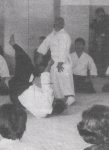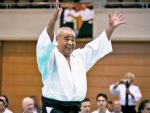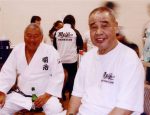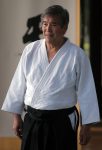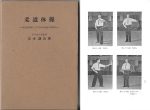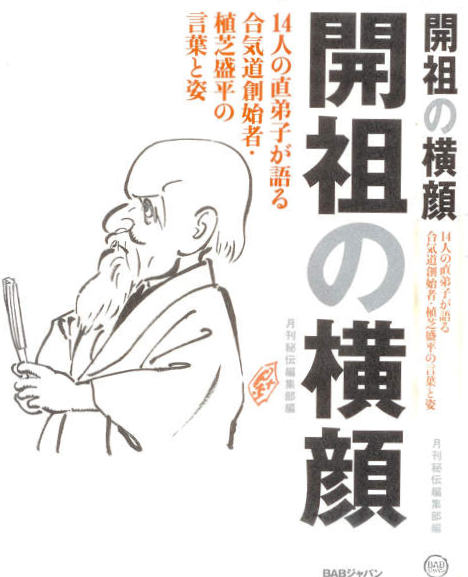
Profiles of the Founder, BAB Japan 2009
開祖の横顔 – 14 interviews with direct students of O-Sensei
開祖の横顔 (Profiles of the Founder) was published in Japanese in 2009 by the publisher of Gekkan Hiden (“Secret Teachings Monthly”), a well known martial arts magazine in Japan.
It contains 14 interviews with direct students of Aikido Founder Morihei Ueshiba. None of these, to my knowledge, have been translated into English, but some of them are quite interesting.
I’m not going to translate any large portion of the interviews, but I’ll pick out a few interesting sections here (note: I haven’t included the Japanese because, unlike Morihei Ueshiba’s own explanations, the speech of his students in these interviews was very straightforward).
Here’s something from Masando Sasaki:
Q: Are there any episodes that you saw directly that left a deep impression on you?
A: You must be talking about Hiroshi Arakawa, the pro-baseball player. When Arakawa came to the dojo and I introduced him, “Sensei, this is Arakawa-sensei, who is famous in baseball”, O-Sensei asked, “Is that the one that you light on fire?”. So I said, “Sensei, that’s O-Kyu” (Note: “moxibustion, as opposed to “yakyu“, which is “baseball”). Since O-Sensei did not know what baseball was, I explained, “You hold a stick (bat) and hit the balls that are thrown to you”. O-Sensei replied, “For something like that why don’t you just cut through with a Japanese sword?” – O-Sensei didn’t quite get the point (laughing).
(…)
Finally, Arakawa eyed the bokken held by O-Sensei and swung at it from the side. At that moment O-Sensei filled himself with Ki and Arakawa and the bat were sent flying.
Arakawa was certainly sent flying at least twice, and then he applied to become a student.
If you’ve seen the First Aikido Friendship Demonstration held in Tokyo in 1985 – Yasuo Kobayashi relates much the same story, in slightly more detail.
Sasaki goes on to relate how they (the students) tried various things in an attempt to discover what O-Sensei had been doing – but could never successfully replicate the feat performed by the Founder.
It’s a good example of “mysterious things we saw the Founder do but none of us ever figured out” – and a good example of what I was discussing in “Aikido and the Unknown“, which brought up the problem of a break in the transmission from Morihei Ueshiba to his students.
That article also included some quotations from “Profiles of the Founder”, mainly relating to the admissions by the students themselves that they had difficulty understanding the teachings of the Founder.
Yasuo Kobayashi was one of those interviewed.
I first met him in the late 1980’s at a an ASU training camp in Boulder. Later on, I trained with a group in Japan that was loosely affiliated with Kobayashi Dojo.
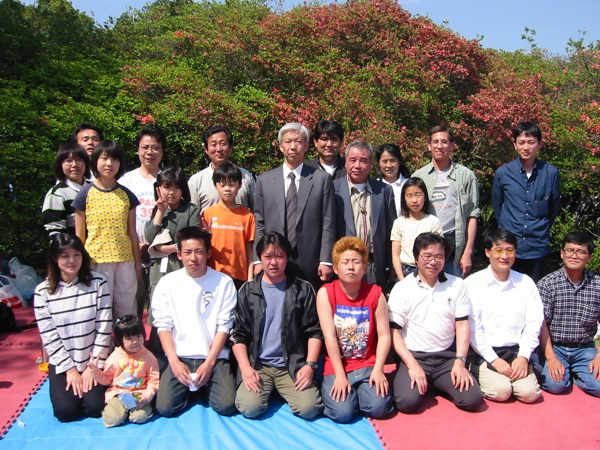
Members of Hasegawa Dojo with Yasuo Kobayashi and
Moriteru Ueshiba Doshu in Iwama
He always impressed me as being direct and down to earth, and his interview reflects that:
Q: What was your impression of when you received instruction or techniques from the Founder.
A: When I was being taught O-Sensei was in his 70’s, and still had plenty of physical power. In Iwama he could still lift bags of rice easily. He was short with broad shoulders and a powerful build. His eyes would be especially sharp when he was holding a bokken or jo. When being thrown by O-Sensei power would be added to the center of your body. When we were thrown in normal practice it would feel like a ball bouncing, but only with O-Sensei it would feel as if we were being crushed when being thrown. That was extremely mysterious. O-Sensei would only show technique, with barely any explanation. He would often speak of the Kojiki or Omoto-kyo, but unfortunately for me understanding the content was like trying to grab clouds. At the time all I could think was “When is he going to start moving?” (laughs). When I recall it now I wish that I had listened more at the time.
In this short section from Kobayashi we see three important points:
- OーSensei gave little or no explanation when instructing. Of course, this contributed to to the problem of transmission discussed above.
- What explanations were given were coached in such esoteric language as to be virtually incomprehensible to the students, most of whom had neither the background nor the interest to dissect what he was saying in order to get at the salient points.
- We see Kobayashi describing a clear difference between how it felt to have the Founder throw you as opposed to having other people throw you in normal practice.
This last one is especially interesting, since it shows the result of points one and two above. This is not an unusual theme among the students of the Founder – Seiichi Sugano put it this way:
“It was as if O-Sensei was doing aikido while everyone else was doing something else.”
Now, here’s the thing…
If you’re studying something (anything) I can understand if your instructor is much more capable then you are, that’s why they’re the instructor. Even though they may be at a higher level it’s clear, however, that you are doing essentially the same thing – this is especially true if you have been studying for some years and are yourself an instructor.
On the other hand, if, after all those years of intense study, it still appears that you are doing something completely different from what your instructor was doing – well, maybe you’re right, maybe you are doing something different.
And that leads us to the second part of the problem, the problem of drift. Since the core of what people are doing has drifted away from the core practice of the Founder, there is now little to keep the training from spinning out of control.
We can see signs that things began to drift away from the core practices of the Founder early after the war in this section from Yasuo Kobayashi:
Q: Is that so – did that have the freestyle (jiyu-waza) demonstrations so common in Aikido at that time?
A: No, that began after the examination system was established. When the membership began to increase a system of kyu and dan examinations was instituted, and the uchi-deshi would take ukemi. However there were never more than around five uchi-deshi, so they could not partner up with the expanding number of students and the students were made to partner with each other for ukemi. At that time freestyle was added as an item on the examination. We held demonstrations from the time that I started, but since basic techniques alone were thought to be boring it was decided to show kokyu-nage as well. Until that time kokyu-nage was not done often in the dojo.
Q: Why was that?
A: O-Sensei did not like kokyu-nage very much. “What good is simply throwing around people like that?” was his thinking. However it was good for training, so it was added to the normal practice. Aiki-nage was much the same – behind the scenes of how freestyle became introduced these kinds of things happened. While we’re discussing this, as far as I know koshi-nage was not practiced much in the beginning. After Nishio and Kuroiwa researched it independently other instructors began to steal their techniques.
You may think that the examples above are fairly harmless, and you’d be right – the instances above are all examples of things done with good intentions.
Not all of the changes were in the same vein – but that is not something that I’m going to get into here.
What I will say is that even changes made with the best of intentions, that seem small and harmless at the time, can very easily lead you down the garden path.
Now, am I saying that nobody got what O-Sensei was doing? Yes and no, it’s not quite that simple.
Every direct student of the Founder that I’ve met (and I’ve met quite a few) seems to have gotten something from the Founder – some a little, and some a lot.
Virtually without exception, however, these students got what they got by the feel of working directly with the Founder, hand to hand. Because of this, those that got what they got seem to share an inability to comprehend exactly what it is that they got, how to explain it, and how to pass it on in turn to their students.
The results, a gradual and steady degradation of skill, ability and knowledge, are plain to see now that there are four or five generations of teachers descending from the Founder, for those who are honest enough to admit it.
It’s just not enough to be able to do, when the art itself is considered. Equally important are the ability to understand, and the ability and willingness to pass on those skills and knowledge.
It’s still not too late, I think, there are a small but growing number of people who are working towards reviving the legacy of the Founder – but time is certainly running short.
Christopher Li – Honolulu, HI

